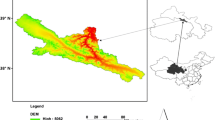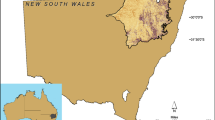Abstract
A variety of statistical techniques has been used in predictive vegetation modelling (PVM) that attempt to predict occurrence of a given community or species in respect to environmental conditions. We compared the performance of three profile models, BIOCLIM, GARP and MAXENT with three nonparametric models of group discrimination techniques, MARS, NPMR and LRT. The two latter models are relatively new statistical techniques that have just entered the field of PVM. We ran all models on a local scale for a given grassland community (Teucrio-Seslerietum) using the same input data to examine their performance. Model accuracy was evaluated both by Cohen’s kappa statistics (κ) and by area under receiver operating characteristics curve based both on resubstitution of training data and on an independent test data set. MAXENT of profile models and MARS of group discrimination techniques achieved the best prediction.
Similar content being viewed by others
Abbreviations
- PVM:
-
Predictive vegetation mapping
- GARP:
-
Genetic algorithm rule-set prediction
- MAXENT:
-
Maximum entropy
- MARS:
-
Multivariate adaptive regression spline
- NPMR:
-
Nonparametric multiplicative regression
- LRT:
-
Logistic regression tree
References
Allouche O, Tsoar A, Kadmon R (2006) Assessing the accuracy of species distribution models: prevalence, kappa and the true skill statistic (TSS). J Appl Ecol 43: 1223–1232
Anderson RP (2003) Real vs. art factual absences in species distributions: tests for Oryzomys albigularis (Rodentia: Muridae) in Venezuela. J Biogeogr 30: 591–605
Anderson RP, Gomez-Laverde M, Peterson AT (2002) Geographical distributions of spiny pocket mice in South America: insights from predictive models. Global Ecol Biogeogr 11: 131–141
Anderson RP, Lew D, Peterson AT (2003) Evaluating predictive models of species’ distributions: criteria for selecting optimal models. Ecol Model 162: 211–232
Austin M (2007) Species distribution models and ecological theory: a critical assessment and some possible new approaches. Ecol Model 200: 1–19
Austin M (2002) Spatial prediction of species distribution: an interface between ecological theory and statistical modelling. Ecol Model 157: 101–118
Beerling DJ, Huntley B, Bailey JP (1995) Climate and the distribution of Fallopia japonica: use of an introduced species to test the predictive capacity of response surfaces. J Veg Sci 6: 269–282
Carpenter G, Gillison AN, Winter J (1993) DOMAIN: a flexible modelling procedure for mapping potential distributions of plants and animals. Biodiversity Conserv 2: 667–680
Chan KY, Loh WY (2004) LOTUS: An algorithm for building accurate and comprehensible logistic regression trees. J Comput Graph Stat 13: 826–852
Ellenberg H (1988) Vegetation ecology of central Europe, 4th edn. Cambridge University Press, New York
Elith J, Graham CH, Anderson RP, Dudik M, Ferrier S, Guisan A, Hijmans R J, Huettmann F, Leathwick J R, Lehmann A, Li J, Lohmann L G, Loiselle BA, Manion G, Moritz C, Nakamura M, Nakazawa Y, Overton JM, Peterson AT, Phillips SJ, Richardson K, Scachetti-Pereira R, Schapire RE, Soberon J, Williams S, Wisz MS, Zimmermann NE (2006) Novel methods improve prediction of species’ distributions from occurrence data. Ecography 29: 129–151
Elith J, Ferrier S, Huettmann F, Leathwick J (2005) The evaluation strip: a new and robust method for plotting predicted responses from species distribution models. Ecol Model 186: 280–289
Fielding AH, Bell JF (1997) A review of methods for the assessment of prediction errors in conservation presence/absence models. Environ Conserv 24: 38–49
Franklin J (1995) Predictive vegetation mapping: geographic modelling of biospatial patterns in relation toenvironmental gradients. Prog Physical Geog 19: 474–499
Guisan A, Edwards TC, Hastie T (2002) Generalized linear and generalized additive models in studies of species distributions: setting the scene. Ecol Model 157: 89–100
Guisan A, Zimmermann N (2000) Predictive habitat distribution models in ecology. Ecol Model 135: 147–186
Heikinnen RK, Luoto M, Virkkala R, Pearson RG, Körber JH (2007) Biotic interactions improve prediction of boreal bird distributions at macro-scales. Glob Ecol Biogeogr 16: 754–763
Hirzel AH, Hausser J, Chessel D, Perrin N (2002) Ecological-niche factor analysis: how to compute habitat- suitability maps without absence data. Ecology 83: 2027–2036
Lehmann A, Overton JM, Leathwick JR (2002) GRASP: Generalized regression analysis and spatial predictions. Ecol Model 157: 187–205
Levine RS, Peterson AT, Benedict MQ (2004) Geographic and ecologic distributions of the Anopheles gambiae complex predicted using a genetic algorithm. Am J Trop Med Hyg 70: 105–109
Malanson GP, Westman GE, Yan YL (1992) Realized versus fundamental niche functions in a model of chaparral response to climatic change. Ecol Model 64: 261–277
McCune B (2006) Nonparametric multiplicative regression for habitat modeling. < http://www.pcord.com/NPMRintro.pdf >
Miller J, Franklin J (2002) Modeling the distribution of four vegetation alliances using generalized linear models and classification trees with spatial dependence. Ecol Model 157: 227–247
Monserud RA, Leemans R (1992) Comparing global vegetation maps with kappa statistic. Ecol Model 62:275–293
Morrison ML, Marcot BG, Mannan RW (1992) Wildlife habitat relationships. Concepts and applications. University Wisconsin Press, Madison, WI
Munoz J, Felicisimo AM (2004) A comparison between some statistical methods commonly used in predictive modeling. J Veg Sci 15: 285–292
Nix HA (1986) A biogeographic analysis of Australian elapid snakes. In: Longmore R (ed) Atlas of elapid snakes of Australia. Australian flora and fauna series number 7. Australian Government Publishing Service, Canberra, p 415
Parra JL, Graham CC, Freile JF (2004) Evaluating alternative data sets for ecological niche models of birds in the Andes. Ecography 27: 350–360
Peterson AT (2001) Predicting species’ geographic distributions based on ecological niche modeling. Condor 103: 599–605
Phillips SJ, Dudik M, Schapire RE (2004) A maximum entropy approach to species distribution modeling. In: Proceedings of the 21st international conference on machine learning. AMC Press, New York, pp 655–662
Phillips SJ, Anderson RP, Schapire RE (2006) Maximum entropy modeling of species geographic distributions. Ecol Model 190: 231–259
Robertson MP, Caithness N, Villet MH (2001) A PCA-based modelling technique for predicting environmental suitability for organisms from presence records. Divers Distrib 7:15–27
Robertson MP, Peter CI, Villet MH, Ripley BS (2003) Comparing models for predicting species’ potential distributions: a case study using correlative and mechanistic predictive modelling techniques. Ecol Model 164: 153–167
Segurado P, Araujo MB (2004) An evaluation of methods for modelling species distributions. J Biogeogr 31: 1555–1568
Stockwell D, Peters D (1999) The GARP modeling System: problems and solutions to automated spatial prediction. Int J Geogr Inf Sys 13: 143–158
Termansen M, McClean CJ, Preston CD (2006) The use of genetic algorithms and Baysian classification to model species distributions. Ecol Model 192: 410–424
Author information
Authors and Affiliations
Corresponding author
Rights and permissions
About this article
Cite this article
Tarkesh, M., Jetschke, G. Comparison of six correlative models in predictive vegetation mapping on a local scale. Environ Ecol Stat 19, 437–457 (2012). https://doi.org/10.1007/s10651-012-0194-3
Received:
Published:
Issue Date:
DOI: https://doi.org/10.1007/s10651-012-0194-3




